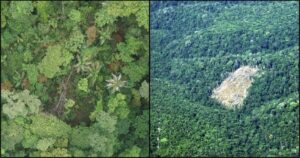Airborne laser scanning reveals the impacts of human activities and natural disturbances in a critical region for carbon dynamics in the Earth system.

Image courtesy of KC Cushman (left) and Marcos Longo (right). Tropical forests are subject to a range of disturbance types, from small-scale mortality from natural processes affecting one or a few trees (left) to anthropogenic clearing of large areas (right).
The Science
The Amazon forest contains globally important carbon stocks, but in recent years, atmospheric
measurements suggest that it has been releasing more carbon than it has absorbed because of
deforestation and forest degradation. However, attributing the sources of carbon loss to forest degradation and natural disturbances remains a challenge. Using repeated high-resolution airborne laser scanning, we found a greater loss of carbon through forest degradation than through deforestation and a net loss of carbon of 90.5 ± 16.6 Tg C y-1 for the study region attributable to both anthropogenic and natural processes.
The Impact
Accurately attributing the sources of carbon loss to forest degradation and natural disturbances remains a challenge because of the difficulty of classifying disturbances and simultaneously estimating carbon changes This study presents a detailed partitioning of aboveground carbon losses and gains in the Amazon forest, improving our understanding of the relative importance of anthropogenic and natural disturbance types. This study highlights the role of forest degradation in the carbon balance for this critical region in the Earth system. The methodology used here also demonstrates the use of randomized samples with airborne remote sensing for scaling observations from local to regional inference.
Summary
Human activities and recent changes in regional climate have caused significant changes to the structure, integrity, and biodiversity of tropical forests. The Brazilian Amazon has experienced severe deforestation and degradation, leading to the region becoming a carbon source rather than a sink in recent decades. However, the relative importance of deforestation, degradation, and natural disturbances for regional carbon dynamics are not well understood. Using randomized, repeated, very high-resolution airborne laser scanning surveys, this study attributed carbon losses among anthropogenic and natural disturbance types, and extrapolated results to the entire Amazonian Arc of Deforestation. Extrapolating the lidar-based statistics to the study area (544,300 km2), we found that 24.1, 24.2, and 14.5 Tg C y-1 were lost through clearing, fires, and logging, respectively. The losses due to large windthrows (21.5 Tg C y-1) and other disturbances (50.3 Tg C y-1) were partially counterbalanced by forest growth (44.1 Tg C y-1). These results highlight the importance of forest degradation—in addition to more commonly studied deforestation—for regional carbon dynamics.
Contact
Lead author:
Name: Ovidiu Csillik
Institution: Jet Propulsion Laboratory, California Institute of Technology, Pasadena, CA – Postdoctoral researcher
Current Institution: Wake Forest University, Winston-Salem, NC – Assistant Professor
Email: ovidiu.csillik@gmail.com
Phone: 213-465-6732
DOE co-author:
Name: KC Cushman
Institution: Oak+++ Ridge National Laboratory
Email: cushmankc@ornl.gov
Phone: 865-924-7364
Funding
- The research of O.C., M.K., A.F., and S.S. carried out at the Jet Propulsion Laboratory, California Institute of Technology, was under a contract with the National Aeronautics and Space Administration (80NM0018D0004).
- The research of K.C.C. was carried out at Oak Ridge National Laboratory, which is managed by the University of Tennessee-Battelle, LLC, under contract DE-AC05-00OR22725 with the U.S. Department of Energy.
- O.C., M.K., M.L., and K.C.C were supported by the Next Generation Ecosystem Experiments‐Tropics, funded by the U.S. Department of Energy, Office of Science, Office of Biological and Environmental Research (DE-AC02-05CH11231).
- E.R.P. was supported by a NASA LCLUC Program grant (20-LCLUC2020-0024).
- Funding for EBA airborne lidar datasets was provided by the Amazon Fund/BNDES (Grant 14.2.0929.1, Improving Biomass Estimation Methods for the Amazon – EBA); Coordenação de Aperfeiçoamento de Pessoal de Nível Superior Brasil (CAPES; Finance Code 001); Conselho Nacional de Desenvolvimento Científico e Tecnológico (Processes 403297/2016-8 and 301661/2019-7).
- Support to generate carbon calibrations was provided by the Sustainable Landscapes Brazil project supported by the Brazilian Agricultural Research Corporation (EMBRAPA), the US Forest Service, and USAID, and the US Department of State.
Publications
- Csillik et al.(NGEE-Tropics Collaboration), “A large net carbon loss attributed to anthropogenic and natural disturbances in the Amazon Arc of Deforestation” Proceedings of the National Academy of Sciences of the United States of America121 (33), e2310157121 (2024). [DOI: 10.1073/pnas.2310157121]
Related Links
Deforestation harms climate less than other types of Amazon degradation, study finds, Reuters, August 5, 2024
Forest degradation releases 5 times more Amazon carbon than deforestation, Mongabay, August 9, 2024